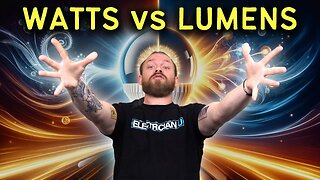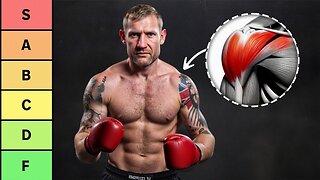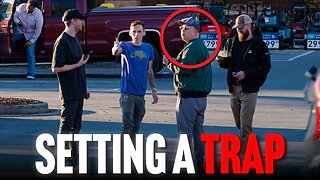Premium Only Content

More Code Terms Explained!!! (What's the Difference Between Damp, Dry and Wet!!!?)
While most of us can probably envision when a scenario is damp, dry, or wet, and some of the associated wording that goes hand in hand with them. In this episode of Electrician U, Dustin talks clears up these terms and discusses some of the terms that go along with those locations to provide a clearer picture for us.
🤘⚡️MEMBERSHIP⚡️🤘
JOIN ELECTRICIAN U - become a member and get:
FREE Continuing Education every year
FREE Practice Exams
FREE Monthly Video Courses
FREE Weekly Live Instructor-Led Classes
FREE Monthly Educational Newsletter
Premium Members-Only Content
Private Discord Channel
Monthly Members-Only Discord Chats
Sign up here --- https://www.electricianu.com/electrician-u-membership/
🎧🎹MUSIC AND VIDEO:🎹🎧
https://www.facebook.com/descantmv
🎬✍️ART AND ILLUSTRATION:✍️🎬
https://www.daverussoart.com
Article 100 of the NEC defines them as such: Location, Damp. Locations protected from weather and not subject to saturation with water or other liquids BUT subject to moderate degrees of moisture. This may be something like a receptacle installed on a patio. Its not DIRECTLY exposed to the pouring rain, but since it is located outside, it is still subject to getting damp depending on the severity of the weather. Location, Wet. Installations underground or in concrete slabs or masonry in direct contact with the earth; in locations subject to saturation with water or other liquids, such as vehicle washing areas; and in unprotected locations exposed to weather. This definition is much more expanded than the last one! So, any installation that is under the ground or exposed to the weather, or that WILL become wet is considered a wet location. Even if it ISN’T currently wet, it could become wet or saturated with water. Just because it doesn’t rain much at all in the Sahara Desert, it doesn’t mean that it COULDN’T!! Location, Dry. A location nor normally subject to dampness or wetness. A location classified as dry may be temporarily subject to dampness or wetness, as in the case of a building under construction. So, the fact that it is somewhere that ISNT exposed to weather may be obvious, the lesser known would be a building that is currently being built. It will eventually be dry but is temporarily subject to dampness or wetness while being worked on.
Rainproof is defined as “Constructed, protected, or treated so as to prevent rain from interfering with the successful operation of the apparatus under specified test conditions. Raintight is close in definition, “Constructed or protected so that exposure to a beating rain will not result in the entrance of water under specified conditions”, but still different. Something that is rainproof is built to still OPERATE in wet conditions, but a raintight item is built to not let water IN. Watertight is “constructed so that moisture will not enter the enclosure under specified test conditions” while Weatherproof is “constructed or protected so that exposure to the weather will not interfere with successful operation. Again, close in definition, but watertight is something made so moisture won’t get INTO it, whereas weatherproof items don’t let exposure to the weather affect OPERATION. Another thing to keep in mind is water is water, but weather could be any weather condition- rain, snow, blowing dirt, salt from the ocean, etc.
Labeled, in a nutshell, means something that is manufactured and marked, but also acceptable to the local AHJ (most cases this is the inspector). Listed, however, can be summarized as an item that has been TESTED by an organization acceptable to the AHJ, and found suitable for a specified purpose.
Identified (as applied to equipment) means recognizable as suitable for the specific purpose, function, use, environment, application, and so forth, where described in a particular CODE requirement. Basically, the item must be suitable and recognizable as what it is described to be. Not hidden or sneaky or something like that. So, something may have a requirement that it its HP, or KVA, or Voltage be identified.
We hope that this video has been helpful in clearing up some of the many confusing code terms that are in our codebooks! Make sure to leave comments below about topics you want to see us produce! Please continue to follow Dustin and Electrician U as we are constantly adding new content to help educate everyone!!
-
 6:27
6:27
Electrician U
1 year ago💡 Watts vs Lumens: The New Lighting Standard You Need to Know! 💡
7.56K6 -
 9:30
9:30
Sugar Spun Run
4 hours agoBlack and White Cookies
31K1 -
 2:45
2:45
SLS - Street League Skateboarding
4 days agoManny Santiago's 'THIS IS 40' Part
18.3K1 -
 6:40
6:40
Homesteading Family
5 days agoNever Make Pie Crust From Scratch Again (Do THIS Instead)
14.2K1 -
 44:20
44:20
Melissa K Norris
3 days ago $0.20 earnedThe Most Overlooked Way to Preserve Food for Months (No Freezer Needed) w/ Sam Knapp
10K1 -
 23:00
23:00
Tony Jeffries
6 days agoThe Best & Worst Boxing Training Methods (Ranked by Olympic Boxer)
7.06K -
 44:44
44:44
Scammer Payback
17 days agoCrazy Confrontation with Hacked Scammer Group
29.5K19 -
 1:15:13
1:15:13
Steven Crowder
3 hours agoIt Isn't Both Sides: They Crossed The Rubicon When They Killed Charlie
348K257 -

The Rubin Report
2 hours ago'Real Time' Crowd Goes Quiet as Bill Maher & Ben Shapiro Have a Tense Exchange About Charlie Kirk
12.9K40 -
 1:49:25
1:49:25
Benny Johnson
2 hours agoTrump Launches 'Major Investigation' of Leftist Plot in Charlie Kirk Murder, FBI New Evidence…
32K69